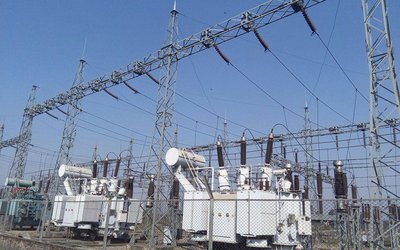"Climate diplomacy" is back. Climate negotiations have entered a serious level, as the stage is set for launching a new round of ambitious negotiations starting the upcoming Doha climate conference in November-December this year. As Nepal has been elected chair of the climate negotiating group of the least developed countries (LDCs) for the next two years, there is a lot to prepare nationally as well as in Nepal's capacity of chairing the world's poorest and most vulnerable countries. It would be worthwhile to understand the politics and diplomacy around climate negotiations, and imperatives of climate diplomacy for Nepal.
The debate on climate change has now moved from science to politics. It is a contested political issue as it requires a massive transformation of the way we live, consume, use resources, and develop our economies. Climate negotiations are not just about controlling emissions, taking actions to mitigate the negative impact emission and help vulnerable and communities to adapt to the adverse impact of global warming. It will require economic, developmental and political decisions to be made in almost a new order, which has been often described as an "inclusive green economy", which addresses the environmental, equity and economic aspects of sustainable development. It will require a low carbon development model, new types of energy use and accounting of the benefits generated by our ecosystems while addressing the questions of social equity and poverty issues.
Under the framework of the 1992 United Nations Framework Convention (UNFCC), climate negotiators are meeting regularly since 2009 under what is called as Conference of Parties (COP) to develop a future discourse on climate, including long-term international policy and commitments under a binding treaty regime. As agreed in the Copenhagen Accord (2009), negotiators are supposed to focus on two tracks. First is the negotiation for a "second commitment period" after the expiry this year of the 1997 Kyoto Protocol on climate change, which is the only available instrument that binds the industrialized countries to take obligatory actions on climate change. Second is the negotiation for long-term enhanced action for creating a legally binding outcome for a future climate discourse. The industrialized countries wanted to proceed with negotiations on a single track, which was rejected by developing countries as that would leave a huge gap of the period without a treaty, probably a decade or more. It is worth remembering that the Kyoto Protocol signed in 1997 took eight years to come into effect in 2005 due to the long ratification process associated with the process.
Though the outcome of Copenhagen was a dismal failure in absence of consensus on the Copenhagen Accord, which was negotiated by a few major powers, and was merely "taken note of" by the Conference of Parties (COP), the highest decision-making body under the UNFCC, it did create a momentum bringing in the erstwhile reluctant players into the fray of climate negotiations. Particularly, the engagement of the United States, which is still outside the regime of Kyoto Protocol, was a significant breakthrough, as was the willingness of so-called "big polluters from developing countries" (India, China, Brazil) to enter into non-binding commitments for action against climate change.
As per the Durban Platform of Enhanced Action, agreed in the COP-16 in December 2011, negotiations will focus on launching new round of climate negotiations to start in 2012 with a view to completing the process of creating "an outcome with legal force" by 2015 that would be implemented from 2020.
Given the polarization of positions and ensuing politics around the issue of climate change, it is foreseen that the negotiation process is going to be painful, arduous and protracted, leaving us without a legally binding regime on climate change probably for a decade or so. There is already disagreement between the industrialized and developing countries as to when to conclude the Kyoto track of negotiations for the second commitment period and how long is such period going to be.
It is good that the debate on climate change has now moved from science, as there is a convergence of view and widespread support of the scientific findings of the Inter-governmental Panel on Climate Change (IPCC), which has already produced its four reports, fifth due by September 2014. There is a broad consensus that the rise of global temperatures should be limited to 2 degrees Celsius at 1990 levels, despite some groups demanding even more ambitious limits as low as 1 degree Celsius. The UNFCC speaks of limiting "dangerous levels anthropogenic interference", leaving the question as to what is "dangerous" and how much of that is "anthropogenic" (human-induced) making it open for scientific and political interpretations.
One of the fundamental bases of new climate negotiations is that it allows both developed and developing to set their own national emission targets and mitigation policy actions. Despite its several flaws like lack of binding nature of commitments, the so-called bottom-up approach, is participatory and has already resulted into the announcement of national emission cut target by several countries including China, Japan, the United States, European Union, and the like. In climate conference in Cancun (2010), 39 non-annex countries pledged their national commitments in this regard, apart from the Annex-I countries which have binding obligations to national commitments on account of their being party to the Kyoto Protocol.
One of the intriguing subjects of negotiations is how to finance the huge climate bill for mitigation and adaptation from climate change. Estimates suggest that something in the order of $ 1 trillion will be required annually to finance actions on mitigation, adaptation, and capacity building globally. The pledge from the European Union countries to make available a paltry 30 billion dollars for 2010–12 and long-term finance of 100 billion dollars per year by 2020 will be peanuts compared to the huge requirement. The developing countries are already insisting that the additional financing requirement should be on top of the already committed Official Development Assistance (ODA) or foreign aid that is available to support the development programs globally. The least developed countries (LDCs) want the industrialized countries to commit 1.5% of their GDP to climate financing on top of committed ODA. How much financing can be sustainable in the context of the global economic slowdown will be a big issue to be confronted with. The developed countries are proposing "innovative" methods of financing climate change programs such as market mechanisms, carbon tax, emission allowances, and the like. The operationalization of the "Green Climate Fund" agreed in Copenhagen, including its governance and easy access to the funds will continue to be debated. For the LDCs, the operationalization of a pledged "LDC Climate Fund" will be of crucial importance in order to support their climate-resilience and adaptation programs. Many LDCs, including Nepal, have already prepared their national and local action plans on climate adaptation, which needs external funding support.
Yet another tricky question in climate negotiations is that of technology transfer, for which developing countries, particularly the LDCs and other vulnerable countries seek concrete commitments from industrialized countries, including financial support for technology transfer, including easy access to technology, easing of the intellectual property restriction and financing for technological capacity building. So, the wording agreed is a "Technology Mechanism", which is shadowy terminology to avoid concrete commitments.
During the Rio+20 summit, climate change figured as one of the most important subjects, as building environmental sustainability in development would be impossible without addressing the huge impact of climate change the world is facing. Therefore, the pledge for an "inclusive green economy' mode and start of negotiation for "sustainable development goals" on the post-Millennium Development Goals compact beyond 2015 will be of crucial importance to address the three pillars of sustainable development, i.e. of environment, equity and economy (so-called 3Es). But failure to come out with concrete commitments at Rio+20 outcome document called "Future We Want", which has been described as one huge "lost opportunity" is likely to impact the outcome of climate negotiations as well.
The Rio+20 declaration reiterated the cardinal principle of climate negotiations, i.e. the principle of "common but differentiated responsibilities (CBDR), which somehow did not find appearance in the Durban Platform, raising alarms in the developing countries. Developing countries have been asserting that it is the responsibility of the industrialized countries to pay for climate bills on account of their contribution to pollution and the ability to pay, which is the central thrust of the CBDR. The developed countries somehow acknowledge this responsibility, though they also want the large polluting developing countries to share the burden and take binding actions, on account of their share of global emissions. Large developing countries account of nearly half of global emissions today.
In November-December 2012, climate negotiators will assemble once again in Doha, as the 18th Conference of Parties (COP-18) under the UNFCC process, including to discuss the future climate regime under the ad hoc working group for negotiations that was established by climate conference in Duran (2011). Among other things, negotiators will start discussing the long-term cooperative action and enhanced international action on emission reduction, mitigation, adaptation, technology transfer and financing.
Developed countries want to limit emission cuts from 20-40% by 2020, which many other groups consider not enough to meet the IPCCC recommendation of achieving 80-90% by 2050. There is no agreement on the modality of mitigation action. The developed countries seem to be ready to allow the developing countries freedom to launch their own policies and non-binding targets, as long as they are internationally quantified, measured and reported transparently, which keeps open the question of compliance and verification. Mitigation policy options including emissions trading, national emission caps, energy intensity targets, reducing emissions from deforestation (REDD), accounting for ecological services of the forests are on the table, but their modalities and allocation of responsibilities and obligations yet to agreed upon.
For countries like Nepal, the test of climate policy and action is how the communities will see a change in their adaptation to the adverse effects of climate change which they are already experiencing. Of crucial importance to Nepal is also the issue of protection of the Himalayan ecosystem against the adverse effect of climate change, including through the melting of glaciers. A comprehensive framework for adaptation will also need to address the needs for disaster risk reduction. The indispensability and vulnerability of the mountain ecosystem in addressing sustainability found a reference in the Rio+20 declaration, thanks to Nepal's diplomacy as chair of the LDCs. This needs to be further pursued. The continuation of the Adaptation Fund created from 2% from CDM under the Kyoto Protocol is also equally important for us.
Given the diverse political interests of various negotiating groups, including the industrialized courtiers (represented by an Umbrella Group), the developing countries (represented by Group of 77 and China), and an alliance of small island nations, the LDCs have a special responsibility and role to play, as the largest recognized negotiating bloc in climate negotiations. Besides, the diverse interests in each of these groups, including the LDCs itself, which comprises of small islands and Sub-Saharan countries as well, will also be a challenging aspect to handle.
Climate negotiation has to face several roadblocks ahead, including divergent seemingly irreconcilable positions leading to polarization of countries on each of the issues, procedural wrangling (even he terms of reference of the ad hoc working group created in Durban remains to be agreed), and lack of an agreed roadmap to negotiations, which working group will have to develop itself. Besides, the decision-making practice by consensus in UNFCC negotiations, as is true with most such international negotiations, will nearly allow all major powers and groups a virtual veto power leading to the possibility of agreement on only the lowest common denominator, which is not what is required in a new ambitious climate change regime.
On the positive side, many large polluting countries have come up with their national targets for emission cuts. Many have pledged for international climate financing. There is a serious engagement of real players like the U.S., India, and China in the negotiations. There are no more divisive scientific questions open.
As negotiating chair on behalf of LDCs, Nepal has a special responsibility and role to play. Nepal's typical problems during bilateral as well as multilateral negotiations are lack of adequate preparations, lack of institutional memory, absence of continuity of personnel, weak mandating, poor sectoral coordination, and weak involvement of stakeholders. Given the cross-cutting nature of climate negotiations, it is welcome that the Government of Nepal has constituted a committee of experts to continue working on the issue and possibly to take part in the negotiations. Yet, there is a need to evolve a negotiating strategy, and to equip our negotiators will all the necessary facts expertise and resources.
In multilateral negotiations, it is said that "Nothing is agreed until everything is agreed". Our negotiators should show skills in making our agenda through in all levels of meetings, including in the plenary, working groups, informal consultations, sideline meetings, etc. It will require building coalitions with other groups such as the G77 and China, and small island states. It is also said that "negotiation is reached when everybody is equally unhappy", something cannot be avoided in multilateral negotiations, as is the common practice of "constructive ambiguity" to mask differences. Negotiators must be equipped with facts and figures and strong communication skills. In climate negotiations, like in every other aspect of negotiations, diplomacy is the power of the weaker. We should seek to enhance our climate diplomacy with this cardinal principle in mind. Nepal should seek to strengthen its climate diplomacy, both in view of maximizing international support its national climate policy and programs, and in view of its international role as chair of the LDC global coordination bureau, as well as the negotiating chair of the LDC climate negotiation group.
Acharya is a former foreign secretary and Nepal's permanent resident representative to the UN. Excerpts of his paper presented at a recently held workshop.

















